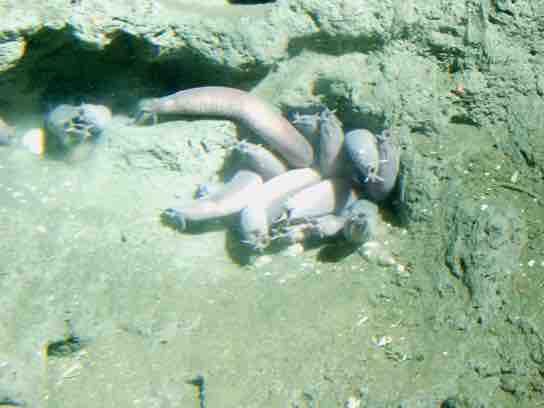Agnathans: Jawless Fishes
Jawless fishes or agnathans are craniates that represent an ancient vertebrate lineage that arose over one half-billion years ago. "Gnathos" is Greek for "jaw" and the prefix "a" means "without," so agnathans are "without jaws. " Most agnathans are now extinct, but two branches still exist today: hagfishes and lampreys. Hagfishes and lampreys are recognized as separate clades, primarily because lampreys are true vertebrates, whereas hagfishes are not. A defining feature of agnathans is the lack of paired lateral appendages or fins.
Some of the earliest jawless fishes were the ostracoderms (Greek for "bone-skin") . Ostracoderms were vertebrate fishes encased in bony armor, unlike present-day jawless fishes, which lack bone in their scales.
Ostracoderm
Ostracoderms were some of the earliest jawless fishes and were covered in bony armor. Present-day jawless fishes lack bone in their scales.
Myxini: Hagfishes
The clade Myxini includes at least 20 species of hagfishes. Hagfishes are eel-like scavengers that live on the ocean floor and feed on dead invertebrates, other fishes, and marine mammals . Hagfishes are entirely marine and are found in oceans around the world, except for the polar regions. Hagfish have slime glands beneath the skin that constantly release mucus, allowing them to escape from the grip of predators. Hagfish can also twist their bodies into a knot to gain a mechanical advantage while feeding and are notorious for eating carcasses from the inside out.

Hagfishes
Pacific hagfish are scavengers that live on the ocean floor. These agnathans are classified as Myxini and do not have a vertebral column.
The skeleton of a hagfish is composed of cartilage, which includes a cartilaginous notochord that runs the length of the body. This notochord provides support to the hagfish's body. Unlike true vertebrates, hagfishes do not replace the notochord with a vertebral column during development. Since they have a cartilaginous skull, they are classified in the clade Craniata.
Petromyzontidae: Lampreys
The clade Petromyzontidae includes approximately 35–40 or more species of lampreys. Lampreys are morphologically similar to hagfishes and also lack paired appendages. However, lampreys develop some vertebral elements as an adult. Their notochord is surrounded by a cartilaginous structure called an arcualia, which may resemble an evolutionarily-early form of the vertebral column.
As adults, lampreys are characterized by a toothed, funnel-like sucking mouth. Many species have a parasitic stage of their life cycle during which they are ectoparasites of fishes . Lampreys live primarily in coastal and fresh waters. They are distributed worldwide, except for the tropics and polar regions. Some species are marine, but all species spawn in fresh water; eggs are fertilized externally. The larvae differ distinctly from the adult form, spending 3 to 15 years as suspension feeders. Once they reach sexual maturity, the adults die within days of reproduction.

Parasitic lampreys
These parasitic sea lampreys attach to their lake trout host by suction and use their rough tongues to rasp away flesh in order to feed on the trout's blood.